From playing soccer with local Italians, to doing research on sustainable wineries, to being speakers at the Food and Sustainability Studies Conference, Mackenzie Nelsen and Jared Belsky took full advantage of their time studying abroad at the Umbra Institute. Mackenzie is an Environmental Science and Interdisciplinary Food Studies double major at University of North Carolina at Chapel Hill, and Jared is an environmental studies major at Hamilton College. During the Spring 2018 semester, they took the Anthropology of Food and Sustainability and Food Production in Italy courses, taught by Professor Elisa Ascione, coordinator of the Food and Sustainability Studies Program (FSSP) at the Umbra Institute.
Nelsen and Jared said they enjoyed class discussions revolving around food. “Academically, it has been very intellectually stimulating,” Mackenzie said. “There’s not a stress associated with learning—it’s learning for the excitement and joy of it, and I’ve learned so much while being here.” Jared added that the anthropological aspect of Professor Ascione’s courses was enlightening and crucial for deciding to spend an extra two months in Perugia researching sustainable wineries in Umbria.
 The Research
The Research
The research conducted by Jared and Mackenzie focused on the figure of Umbria’s alternative and sustainable vignaioli, an Italian word indicating both winegrowers and winemakers. “Our research is basically travelling to different wineries around Umbria and meeting with their owners to interview them about their specific viticulture practices and perceptions of terroir, sustainability, farmer identity,” Jared explained. As far as the research methods are concerned, students recorded, transcribed and analyzed every interview, and every observation that they made. According to Jared, this was helpful because it was possible to go back and find answers to questions they did not even asked, and even answers to some new questions they did not think of. “We did qualitative research, analyzing sustainability through the point of view of our informants: we collected the data through Theoretical Sampling.” He said. “We have also used Snowball Sampling, which means some of our fieldwork has been determined by the participants themselves; in this case, some of the winemakers we visited recommended that we go see another winery that wasn’t on our previous list.” Jared said.
The research allowed both students to deepen their knowledge about sustainable agriculture and about the motivations behind a farmer’s choice to produce sustainable wines. “One of the most memorable moments was when we saw a rally in the center of Perugia with lots of tractors,” Mackenzie said. “Most of the people we interviewed during field research were there, demonstrating for better regulations in the agriculture sector. We talked to them and they were so passionate about their work, so we understood their way of thinking. It was great to be there with them and share their concerns.”
 Speakers at The Food Conference
Speakers at The Food Conference
Jared and Mackenzie had the opportunity to present her research at the Food and Sustainability Studies Conference, an event organized every two years by the Umbra Institute, which sees the participation of renowned academics. “It was very exciting,” Mackenzie said. “Although it was a bit intimidating to present our research in front of other professionals, we felt the support of Elisa and the Umbra Institute.” This experience as speakers allowed the students to develop some new skills. “In college you write many essays, but here it was different because when you focus on one topic for so many weeks, you get so much material from your readings and the fieldwork. Having to synthetize all of that has been a learning experience that is important for my future.” Mackenzie said.
The impact of the Umbra experience on their studies
This research, together with the above-mentioned courses, has had a significant impact on the students’ approach to their studies. “I’ve always focused on environmental sciences and this was my first time doing anthropology,” Mackenzie said. “When I took Elisa’s classes, I really fell in love with her anthropological approach. I think it shifted my direction quite a bit because, coming from a food studies and sustainability perspective, I learned that anthropology is a great method to explore those ideas. So, this research experience gave me the opportunity to share what I’ve written and seen and, beyond the practical aspect, it reframed my way of thinking and the kind of the path of what I want to follow.”
Jared has also some ideas about how to take advantage of what he has learned. “This is very much in the works, but I hope to develop this project as one half of a senior thesis for next year.” He said. “It would be interesting to do some sort of comparative analysis with terroir between wine in Italy and cider in the US.”
To learn more about Food & Sustainability Studies at the Umbra Institute, click here.


 The balance of the 2018 campaign was presented during the usual press conference held at the end of the excavation, on Friday, July 6th in Castiglione del Lago. Among the speakers were the mayor of Castiglione, Dr. Sergio Batino; representatives from the Archeological Superintendency of Umbria; and the Director of the archaeological excavation, Professor Rebecca Schindler (DePauw University).
The balance of the 2018 campaign was presented during the usual press conference held at the end of the excavation, on Friday, July 6th in Castiglione del Lago. Among the speakers were the mayor of Castiglione, Dr. Sergio Batino; representatives from the Archeological Superintendency of Umbria; and the Director of the archaeological excavation, Professor Rebecca Schindler (DePauw University).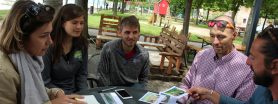 Inspired by a field trip with one of her classes, Umbra professor Dr. Brooke Porter decided to conduct research on the fishermen and the impact of fish biodiversity at Lake Trasimeno, 30 minutes away from Perugia. On the field trip, Dr. Porter noticed that the fishermen lamented about the introduction of goldfish to the lake while at the same time celebrating a recent catch of largemouth bass, another introduced species. “This dissention made me think about how the fishers identify with and understand the biodiversity of the lake,” Dr. Porter said. She added that “the aim of the research is to unpack the understanding of fisherfolk of fish biodiversity in Lake Trasimeno.”
Inspired by a field trip with one of her classes, Umbra professor Dr. Brooke Porter decided to conduct research on the fishermen and the impact of fish biodiversity at Lake Trasimeno, 30 minutes away from Perugia. On the field trip, Dr. Porter noticed that the fishermen lamented about the introduction of goldfish to the lake while at the same time celebrating a recent catch of largemouth bass, another introduced species. “This dissention made me think about how the fishers identify with and understand the biodiversity of the lake,” Dr. Porter said. She added that “the aim of the research is to unpack the understanding of fisherfolk of fish biodiversity in Lake Trasimeno.”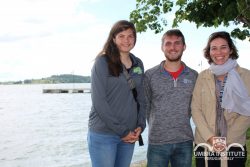 Still in the midst of conducting fieldwork, Dr. Porter presented her preliminary findings on June 9 at the 2018 Food Conference: Perugia hosted by the Umbra Institute. “The results are showing that the economic value of fish is important,” she said. “The data to date has also shown that fishers have a solid understanding of the food web.”
Still in the midst of conducting fieldwork, Dr. Porter presented her preliminary findings on June 9 at the 2018 Food Conference: Perugia hosted by the Umbra Institute. “The results are showing that the economic value of fish is important,” she said. “The data to date has also shown that fishers have a solid understanding of the food web.”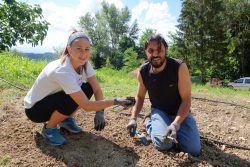 For Nicole, an occupational therapy student at Misericordia University, “The Café Alzheimer at Fontenuovo was incredibly eye-opening. I’ve been around many people affected by Alzheimer’s, and the dynamic approach used by Fontenuovo’s therapists in dealing with the patients is amazing. Family members come to see their relatives and do activities with them. [By doing this] they are able to connect on a different level.” She adds, “Fontenuovo is different from the facilities I’ve seen in the States. It does not look like a hospital, it feels like home.”
For Nicole, an occupational therapy student at Misericordia University, “The Café Alzheimer at Fontenuovo was incredibly eye-opening. I’ve been around many people affected by Alzheimer’s, and the dynamic approach used by Fontenuovo’s therapists in dealing with the patients is amazing. Family members come to see their relatives and do activities with them. [By doing this] they are able to connect on a different level.” She adds, “Fontenuovo is different from the facilities I’ve seen in the States. It does not look like a hospital, it feels like home.” 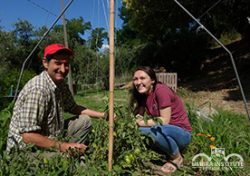 Keana, a biology and medical and health humanities double major at Misericordia University, loved the experience at the synergistic garden. “The patients there are so welcoming and happy to be there with us. It has been an incredible experience, making meaningful relationships with them and learning their stories and the way they live”, Keana expressed. “We’re understanding more about both the Italian culture and the patients’ lives on a day-to-day basis.”
Keana, a biology and medical and health humanities double major at Misericordia University, loved the experience at the synergistic garden. “The patients there are so welcoming and happy to be there with us. It has been an incredible experience, making meaningful relationships with them and learning their stories and the way they live”, Keana expressed. “We’re understanding more about both the Italian culture and the patients’ lives on a day-to-day basis.”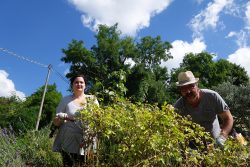 Kasey was inspired by all the social workers she met in these facilities. “My major is in social work, so one of the coolest things was to see social services in a multicultural perspective. Hearing about the educational background of the social workers and seeing how their personalities influence the way they help other people was totally catered to me. I liked being able to connect with someone so different from myself but who shares the same passion as me.”
Kasey was inspired by all the social workers she met in these facilities. “My major is in social work, so one of the coolest things was to see social services in a multicultural perspective. Hearing about the educational background of the social workers and seeing how their personalities influence the way they help other people was totally catered to me. I liked being able to connect with someone so different from myself but who shares the same passion as me.”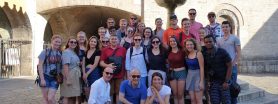 In Italy it is easy to come across a medieval village, but it’s not every day that you visit one of the most beautiful historical re-enactments in the country. The students of the Intensive Italian Program had this opportunity in Bevagna, a few kilometers from Perugia, where the Gaite Market takes place every year. The purpose of this event is to faithfully recreate the lives of the inhabitants of Bevagna between 1250 and 1350, demonstrating the activities that took place in the past. The whole village participates in this festival by reopening the old “botteghe” such as the paper shop, the candle factory and the clothes dyeing service.
In Italy it is easy to come across a medieval village, but it’s not every day that you visit one of the most beautiful historical re-enactments in the country. The students of the Intensive Italian Program had this opportunity in Bevagna, a few kilometers from Perugia, where the Gaite Market takes place every year. The purpose of this event is to faithfully recreate the lives of the inhabitants of Bevagna between 1250 and 1350, demonstrating the activities that took place in the past. The whole village participates in this festival by reopening the old “botteghe” such as the paper shop, the candle factory and the clothes dyeing service. 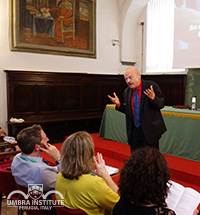 The fourth edition of the biennial Perugia Food Conference took place June 7-10 at at the Umbra Institute in Perugia, Italy. The theme of the conference, organized by the Umbra Institute’s new
The fourth edition of the biennial Perugia Food Conference took place June 7-10 at at the Umbra Institute in Perugia, Italy. The theme of the conference, organized by the Umbra Institute’s new 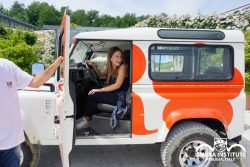 A semester abroad, a course on Business of Wine, an
A semester abroad, a course on Business of Wine, an 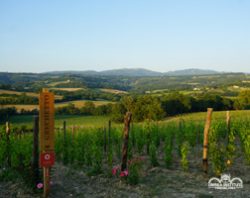 She also took part in Cantine Aperte (“Open Wineries”), a national event that involves hundreds of Italian wineries in late May. This event, which aims to promote the culture of wine in a festive atmosphere, took place during the final days of her time at Roccafiore. What a great way to end an internship!
She also took part in Cantine Aperte (“Open Wineries”), a national event that involves hundreds of Italian wineries in late May. This event, which aims to promote the culture of wine in a festive atmosphere, took place during the final days of her time at Roccafiore. What a great way to end an internship!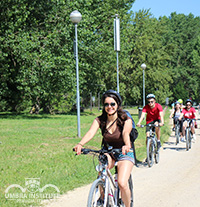 This past Friday, the Umbra Institute’s Intensive Italian summer students hopped on a train and took a bike ride around Lake Trasimeno with a guide, who explained in Italian the history of the Umbrian lake and the area. The guided tour gave students the opportunity to improve their comprehension and speaking skills in a fun and active environment. Biking from Passignano sul Trasimeno to Tuoro sul Trasimeno, the students then took the ferry to Isola Maggiore, one of the three islands in the lake. Along the way, they asked the guide questions in Italian to learn more about the area. Here are some fun historical facts they learned:
This past Friday, the Umbra Institute’s Intensive Italian summer students hopped on a train and took a bike ride around Lake Trasimeno with a guide, who explained in Italian the history of the Umbrian lake and the area. The guided tour gave students the opportunity to improve their comprehension and speaking skills in a fun and active environment. Biking from Passignano sul Trasimeno to Tuoro sul Trasimeno, the students then took the ferry to Isola Maggiore, one of the three islands in the lake. Along the way, they asked the guide questions in Italian to learn more about the area. Here are some fun historical facts they learned: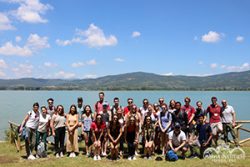 3. St. Francis of Assisi stayed on Isola Maggiore for forty days to fast. He was given a loaf of bread and a rabbit as food, but instead of eating the rabbit he fed it pieces of bread.
3. St. Francis of Assisi stayed on Isola Maggiore for forty days to fast. He was given a loaf of bread and a rabbit as food, but instead of eating the rabbit he fed it pieces of bread.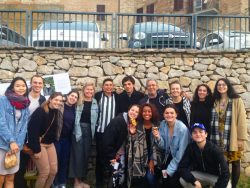 Students and community members came together to promote an often-overlooked area of Perugia called Borgo Bello at the
Students and community members came together to promote an often-overlooked area of Perugia called Borgo Bello at the 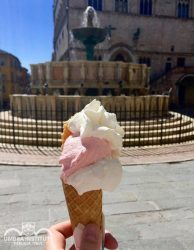 1. Big backpack or duffel bag
1. Big backpack or duffel bag